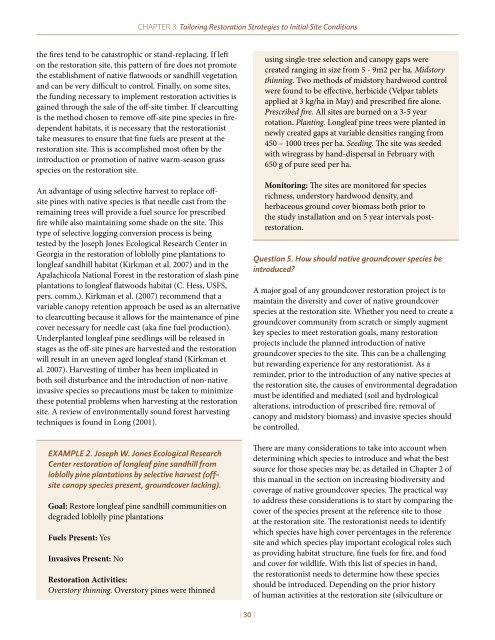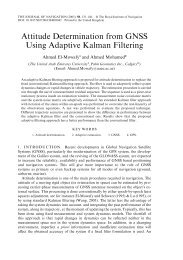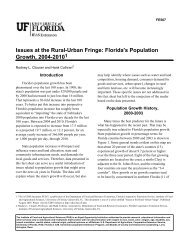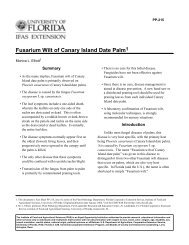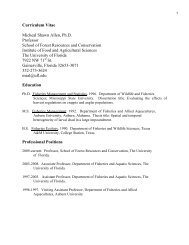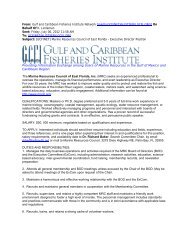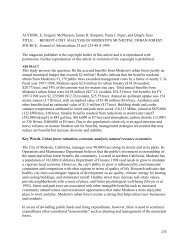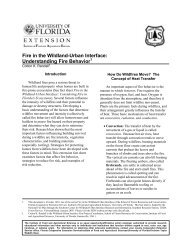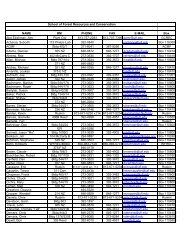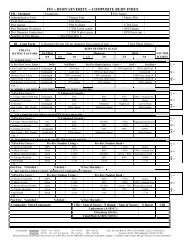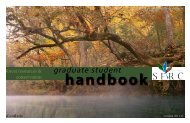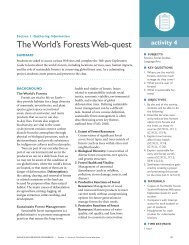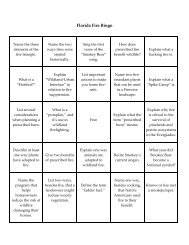Groundcover Restoration in Forests of the Southeastern United States
Groundcover Restoration in Forests of the Southeastern United States
Groundcover Restoration in Forests of the Southeastern United States
You also want an ePaper? Increase the reach of your titles
YUMPU automatically turns print PDFs into web optimized ePapers that Google loves.
Chapter 3: Tailor<strong>in</strong>g <strong>Restoration</strong> Strategies to Initial Site Conditions<strong>the</strong> fires tend to be catastrophic or stand-replac<strong>in</strong>g. If lefton <strong>the</strong> restoration site, this pattern <strong>of</strong> fire does not promote<strong>the</strong> establishment <strong>of</strong> native flatwoods or sandhill vegetationand can be very difficult to control. F<strong>in</strong>ally, on some sites,<strong>the</strong> fund<strong>in</strong>g necessary to implement restoration activities isga<strong>in</strong>ed through <strong>the</strong> sale <strong>of</strong> <strong>the</strong> <strong>of</strong>f-site timber. If clearcutt<strong>in</strong>gis <strong>the</strong> method chosen to remove <strong>of</strong>f-site p<strong>in</strong>e species <strong>in</strong> firedependenthabitats, it is necessary that <strong>the</strong> restorationisttake measures to ensure that f<strong>in</strong>e fuels are present at <strong>the</strong>restoration site. This is accomplished most <strong>of</strong>ten by <strong>the</strong><strong>in</strong>troduction or promotion <strong>of</strong> native warm-season grassspecies on <strong>the</strong> restoration site.An advantage <strong>of</strong> us<strong>in</strong>g selective harvest to replace <strong>of</strong>fsitep<strong>in</strong>es with native species is that needle cast from <strong>the</strong>rema<strong>in</strong><strong>in</strong>g trees will provide a fuel source for prescribedfire while also ma<strong>in</strong>ta<strong>in</strong><strong>in</strong>g some shade on <strong>the</strong> site. Thistype <strong>of</strong> selective logg<strong>in</strong>g conversion process is be<strong>in</strong>gtested by <strong>the</strong> Joseph Jones Ecological Research Center <strong>in</strong>Georgia <strong>in</strong> <strong>the</strong> restoration <strong>of</strong> loblolly p<strong>in</strong>e plantations tolongleaf sandhill habitat (Kirkman et al. 2007) and <strong>in</strong> <strong>the</strong>Apalachicola National Forest <strong>in</strong> <strong>the</strong> restoration <strong>of</strong> slash p<strong>in</strong>eplantations to longleaf flatwoods habitat (C. Hess, USFS,pers. comm.). Kirkman et al. (2007) recommend that avariable canopy retention approach be used as an alternativeto clearcutt<strong>in</strong>g because it allows for <strong>the</strong> ma<strong>in</strong>tenance <strong>of</strong> p<strong>in</strong>ecover necessary for needle cast (aka f<strong>in</strong>e fuel production).Underplanted longleaf p<strong>in</strong>e seedl<strong>in</strong>gs will be released <strong>in</strong>stages as <strong>the</strong> <strong>of</strong>f-site p<strong>in</strong>es are harvested and <strong>the</strong> restorationwill result <strong>in</strong> an uneven aged longleaf stand (Kirkman etal. 2007). Harvest<strong>in</strong>g <strong>of</strong> timber has been implicated <strong>in</strong>both soil disturbance and <strong>the</strong> <strong>in</strong>troduction <strong>of</strong> non-native<strong>in</strong>vasive species so precautions must be taken to m<strong>in</strong>imize<strong>the</strong>se potential problems when harvest<strong>in</strong>g at <strong>the</strong> restorationsite. A review <strong>of</strong> environmentally sound forest harvest<strong>in</strong>gtechniques is found <strong>in</strong> Long (2001).EXAMPLE 2. Joseph W. Jones Ecological ResearchCenter restoration <strong>of</strong> longleaf p<strong>in</strong>e sandhill fromloblolly p<strong>in</strong>e plantations by selective harvest (<strong>of</strong>fsitecanopy species present, groundcover lack<strong>in</strong>g).Goal: Restore longleaf p<strong>in</strong>e sandhill communities ondegraded loblolly p<strong>in</strong>e plantationsFuels Present: YesInvasives Present: No<strong>Restoration</strong> Activities:Overstory th<strong>in</strong>n<strong>in</strong>g. Overstory p<strong>in</strong>es were th<strong>in</strong>nedus<strong>in</strong>g s<strong>in</strong>gle-tree selection and canopy gaps werecreated rang<strong>in</strong>g <strong>in</strong> size from 5 - 9m2 per ha. Midstoryth<strong>in</strong>n<strong>in</strong>g. Two methods <strong>of</strong> midstory hardwood controlwere found to be effective, herbicide (Velpar tabletsapplied at 3 kg/ha <strong>in</strong> May) and prescribed fire alone.Prescribed fire. All sites are burned on a 3-5 yearrotation. Plant<strong>in</strong>g. Longleaf p<strong>in</strong>e trees were planted <strong>in</strong>newly created gaps at variable densities rang<strong>in</strong>g from450 – 1000 trees per ha. Seed<strong>in</strong>g. The site was seededwith wiregrass by hand-dispersal <strong>in</strong> February with650 g <strong>of</strong> pure seed per ha.Monitor<strong>in</strong>g: The sites are monitored for speciesrichness, understory hardwood density, andherbaceous ground cover biomass both prior to<strong>the</strong> study <strong>in</strong>stallation and on 5 year <strong>in</strong>tervals postrestoration.Question 5. How should native groundcover species be<strong>in</strong>troduced?A major goal <strong>of</strong> any groundcover restoration project is toma<strong>in</strong>ta<strong>in</strong> <strong>the</strong> diversity and cover <strong>of</strong> native groundcoverspecies at <strong>the</strong> restoration site. Whe<strong>the</strong>r you need to create agroundcover community from scratch or simply augmentkey species to meet restoration goals, many restorationprojects <strong>in</strong>clude <strong>the</strong> planned <strong>in</strong>troduction <strong>of</strong> nativegroundcover species to <strong>the</strong> site. This can be a challeng<strong>in</strong>gbut reward<strong>in</strong>g experience for any restorationist. As arem<strong>in</strong>der, prior to <strong>the</strong> <strong>in</strong>troduction <strong>of</strong> any native species at<strong>the</strong> restoration site, <strong>the</strong> causes <strong>of</strong> environmental degradationmust be identified and mediated (soil and hydrologicalalterations, <strong>in</strong>troduction <strong>of</strong> prescribed fire, removal <strong>of</strong>canopy and midstory biomass) and <strong>in</strong>vasive species shouldbe controlled.There are many considerations to take <strong>in</strong>to account whendeterm<strong>in</strong><strong>in</strong>g which species to <strong>in</strong>troduce and what <strong>the</strong> bestsource for those species may be, as detailed <strong>in</strong> Chapter 2 <strong>of</strong>this manual <strong>in</strong> <strong>the</strong> section on <strong>in</strong>creas<strong>in</strong>g biodiversity andcoverage <strong>of</strong> native groundcover species. The practical wayto address <strong>the</strong>se considerations is to start by compar<strong>in</strong>g <strong>the</strong>cover <strong>of</strong> <strong>the</strong> species present at <strong>the</strong> reference site to thoseat <strong>the</strong> restoration site. The restorationist needs to identifywhich species have high cover percentages <strong>in</strong> <strong>the</strong> referencesite and which species play important ecological roles suchas provid<strong>in</strong>g habitat structure, f<strong>in</strong>e fuels for fire, and foodand cover for wildlife. With this list <strong>of</strong> species <strong>in</strong> hand,<strong>the</strong> restorationist needs to determ<strong>in</strong>e how <strong>the</strong>se speciesshould be <strong>in</strong>troduced. Depend<strong>in</strong>g on <strong>the</strong> prior history<strong>of</strong> human activities at <strong>the</strong> restoration site (silviculture or| 30 |


